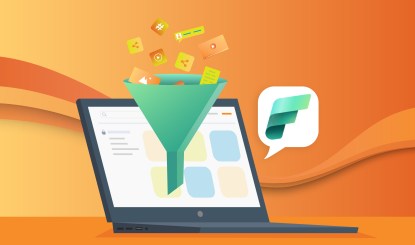Microsoft has announced that it will be streamlining its data engineering and business intelligence offerings with its release of Microsoft Fabric. The tool will combine the existing BI tools that Microsoft has been supporting and enhancing over the years to enable business intelligence professionals to store and access their data in a cloud-based environment across the entirety of their organization – and do so in a more unified and consolidated way.
What this means for our customers is that the barrier to understanding and investing in and using BI tools has been lowered, making it easier for organizations of every size to unleash the power of their data.
What is Microsoft Fabric?
Microsoft Fabric is being billed as an end-to-end, unified analytics platform – data platforms and analytics in a box. It allows users to pull data from all sources that an organization might use – whether it’s housed in Azure, AWS, or Google Cloud Platform – and move it to a cloud-based data lake called OneLake. By centralizing an organization’s data in one place, leaders are better able to parse what the information is telling them and how it will impact their business. Even better, this centralization of lake data does not require the organization to move or duplicate data to other places. Shortcuts are used within OneLake to help bring an organization’s cloud data estate together for ease of analysis and governance.
Moreover, Fabric doesn’t stop at simply centralizing an organization’s data in one repository; it also provides users access to Power BI to help analyze the information and visualize the data so insights can be pulled from it. With the integration of Copilot, Microsoft Fabric’s data analytics tools will be able to extend the capabilities of business intelligence professionals and decrease the time it takes to derive value from a business’s information.
Why Does Microsoft Fabric Matter?
Essentially, it provides a turnkey solution for a business’s data and analytics platforms.
While everyone’s aware there’s a suite of business intelligence tools that an organization can invest in, many businesses experience difficulties with trying to understand what they are and implement them. Microsoft Fabric streamlines this process by creating a single pane of glass from which you can manage your organization’s data and reporting.
Previously, housing data in different toolsets meant that you had to call in a highly technical team to wire them together so that all the “moving parts” would talk to one another, requiring a serious investment of resources. This delay in time made it harder to derive critical insights from an organization’s data estates.
For data transmission, transformation, normalization, mining, and ultimately insightful visualization, Microsoft Fabric enables users to access Data Factory, Synapse Data Science, Synapse Data Warehousing, Synapse Real-Time Analytics, and Power BI to create a drag-and-drop interface for professionals to organize their data workflows, access real-time information from connected devices, and uncover insights through sophisticated analytics.
In addition to having a centralized location and analytics system, Microsoft is making Copilot available in each of the tools that comprise Fabric, meaning that it will eventually be possible to provide AI-powered chat bot assistance in generating analyses and graphs, further streamlining the reporting process.
Will Fabric Change Anything About the Microsoft Environment?
The quick answer is that it depends on your perspective.
Fabric does impact Microsoft’s data tools in the sense that centralizing them enables users to quickly and easily navigate their organization’s data, and that will boost the effectiveness of BI professionals in providing insights to organizational leaders. Plus, Fabric’s licensing model will mean businesses have access to a more consolidated process for administering their environment and handling their data cloud consumption spend.
However, if your business already uses Power BI, Synapse Data Warehousing, Data Factory, or any of the other tools that will fall under the Fabric umbrella, then you don’t have to do anything different. The tools will be accessible from a centralized platform through Fabric and you’ll still be able to access existing APIs that you may have built for your data sources.
What If I’ve Already Got a Turnkey Analytics Solution?
Microsoft Fabric is a robust tool, but it’s entirely possible that organizations are already using a provider like Snowflake and Data Bricks and are happy with the way it’s working. In cases like these, it’s possible that organizations don’t really need to switch over, assuming that everything’s been set up in a way that benefits the business.
However, a key difference between those other solutions and Microsoft’s new offering is that Fabric offers easy integration into organizational tech stacks (such as M365, D365, and Azure) that rely on Microsoft services and platforms as its base. Since all of Fabric’s components are existing Microsoft products, they don’t require unique integrations to tie back into the IT environment. Plus, Microsoft’s security measures are some of the most robust, meaning that using it requires less of an investment in securing your organization’s data.
The other key difference of note (already being called a competitor killer in the tech rags) is OneLake. Until now, no one has attempted to consolidate and simplify the concept of data lakes and data lake houses. Nor has there been a data lake offering that so easily connects to other disparate cloud systems like AWS and Google, while still applying best-in-class data governance. Their goal with OneLake is to eventually be the sole data source or point of entry for not only Microsoft system data, but 3rd party services as well.
Microsoft Fabric Grounds Organizational Decisions in Data
Data-driven insights are a key part of any effective strategy in the modern world, and that means that organizations need to have insight into the massive amounts of information they collect on a daily basis. There have been a wide range of analytics tools that enable organizations to organize and visualize data, but often there are siloes that can delay the time it takes for an insight to reach business leaders.
With Microsoft Fabric, businesses of all sizes are able to prepare and use data to inform their decision-making process so that leaders can navigate changes in their industry quickly and efficiently. There’s an immense amount of value businesses hold when it comes to their data, but it requires effective preparation, normalization, analysis, and governance to unlock it.
If you’re interested in finding out how updated modern analytics tools can benefit your business, see how FinPro opened a new line of business with the help of analytics tools here.



